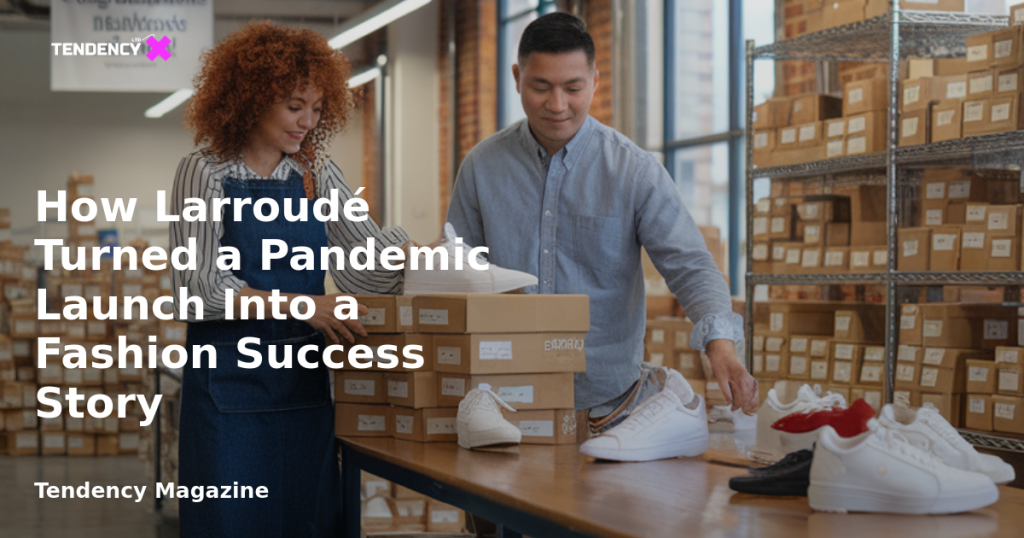How Larroudé Turned a Pandemic Launch Into a Fashion Success Story

Launching a fashion brand during a global pandemic might seem like an ill-timed venture, but for Marina and Ricardo Larroudé, it was a unique opportunity. With a modest $4,000, a Shopify website, and a clear vision, they transformed Larroudé into a thriving business, recognized by Fast Company as one of the Most Innovative Companies and by Footwear News as Brand of the Year. This article explores how the Larroudés bootstrapped their way to success, the strategic advantages of vertical integration, their innovative direct-to-demand model, and the dynamics of building a business with a spouse.
Table of Contents:
- Starting Small and Celebrating Every Milestone
- The Strategic Leap into Vertical Integration
- Innovating Fashion with a Direct-to-Demand Model
- Navigating Business and Marriage Together
- Conclusion
Starting Small and Celebrating Every Milestone
When Marina and Ricardo Larroudé launched their brand, they didn’t start with a hefty investment. Instead, they relied on their savings, a Shopify platform, and a few samples to test the waters. Marina recalls their early days with fondness: “In our second month, we sold $5,000 worth of products, and we celebrated. Now, we achieve that in minutes, yet we continue to celebrate every milestone.”
The Larroudés’ bootstrap mentality was crucial. They scaled their production only after validating market demand. Ricardo explains their disciplined approach: “We started gradually. Trying things doesn’t cost much, but once you find something that works, you invest in it.”
This strategy underscores the importance of patience and discipline for other entrepreneurs, emphasizing the need to validate demand before making significant investments.
The Strategic Leap into Vertical Integration
As Larroudé’s orders increased, the limitations of outsourced production became evident. Ricardo recalls the frustration of delayed timelines: “I would call the factory and say, ‘I need 600 more.’ They’d respond, ‘OK, in 120 days.’” This delay meant missing crucial selling seasons.
The solution? Establishing their own factory in Brazil. Ricardo discovered that the cost of a large outsourced order was comparable to purchasing used machinery outright. By controlling their production, Larroudé could replenish bestsellers quickly, maintain quality control, and experiment with new designs.
Vertical integration provided Larroudé with a competitive edge, allowing them to respond swiftly to market trends and maintain momentum in an industry where timing is everything.
Innovating Fashion with a Direct-to-Demand Model
Ricardo compares traditional fashion to grocery stores overstocking perishables, leading to waste. Larroudé, on the other hand, produces only what customers order. “Fashion is perishable,” he notes. They adopted a model akin to a pizzeria: keeping materials ready and producing items on demand.
By inviting customers to preorder collections, often at discounted rates, Larroudé gains immediate insights into popular styles. Marina highlights their agility: “If a client loves a particular shoe, we design similar ones and launch them within a week.”
This approach minimizes unsold inventory, allows for real-time demand response, and creates excitement around each release. For customers, it feels less like shopping and more like participating in the creative process.
Navigating Business and Marriage Together
Running a fast-growing brand as a married couple presents unique challenges, but Marina and Ricardo attribute their success to honesty. “We have all the hard conversations,” Marina says, emphasizing the importance of open communication. While they are co-founders, their roles are distinct: Ricardo serves as CEO, while Marina leads creative direction.
Ricardo stresses that their relationship thrives on constant communication and trust. “We’re best friends,” he says, noting that clearly defined roles are crucial for both the company and their marriage. This clarity fosters alignment across teams.
The Larroudés’ experience illustrates that co-founder partnerships, whether between spouses or not, benefit from radical honesty, trust, and clear role definitions. Their strong foundation has enabled them to navigate hypergrowth and lead a large team effectively.
Conclusion
Larroudé’s journey from a modest startup to a 550-person company with nine-digit revenue demonstrates that resourcefulness, strategic vertical integration, customer-driven production, and a strong partnership can drive rapid and smart growth, even in challenging times. Their story serves as an inspiring example for entrepreneurs looking to make their mark in the fashion industry or any other sector.
2025 Tendency LTD. All rights reserved.

